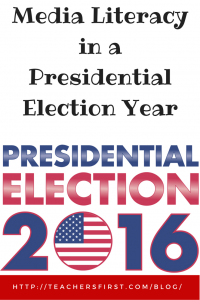 Bombarded by television ads in this presidential election year, especially in battleground states, many of us tend to press the mute button on the remote or change the station. However, as teachers, we should be thinking about the messages our students are getting when watching TV and as they live their everyday virtual lives.
Bombarded by television ads in this presidential election year, especially in battleground states, many of us tend to press the mute button on the remote or change the station. However, as teachers, we should be thinking about the messages our students are getting when watching TV and as they live their everyday virtual lives.
Media literacy, especially understanding the role of the news media and the influence of advertising, is critical to our students. Not just during election times, but each day as they navigate their world saturated with media messages in many formats. Teaching about media literacy can be part of any grade level or content area, but is especially important for social studies and English language arts.
The Center for Media Literacy offers this definition:
“Media Literacy is a 21st-century approach to education. It provides a framework to access, analyze, evaluate, create and participate with messages in a variety of forms — from print to video to the Internet. Media literacy builds an understanding of the role of media in society as well as essential skills of inquiry and self-expression necessary for citizens of a democracy.”
The National Association for Literacy Education provides Core Principles of Media Literacy, including these.
- Media Literacy Education requires active inquiry and critical thinking about the messages we receive and create.
- Media Literacy Education expands the concept of literacy (i.e., reading and writing) to include all forms of media.
- Media Literacy Education builds and reinforces skills for learners of all ages. Like print literacy, those skills necessitate integrated, interactive, and repeated practice.
- Media Literacy Education develops informed, reflective and engaged participants essential for a democratic society.
Let me share some resources that are helpful for teaching media literacy, especially as it involves our American political process.
General information on media literacy:
- A favorite source for teaching about media literacy is the Media Literacy Clearinghouse, maintained by Frank W. Baker. Especially helpful is the section on Media and Politics which provides teaching resources about the role of media in elections, focusing on advertising and political cartoons.
- The Media Education Lab holds many resources on media literacy, including a helpful page of curriculum links. It also hosts Mind Over Media, Analyzing Contemporary Propaganda which has educational materials for teaching about propaganda, including in elections.
- Media Smarts may be a Canadian organization, but its website supports digital and media literacy through its educational materials for teaching students of all ages.
- Early Childhood Investigations site offers this helpful rubric for any age level, Key Questions to Ask When Analyzing Media Messages.
- PBS LearningMedia hosts videos and lesson plans. For our youngest students ages 4-7, Between the Lions, Watch This Ad is a beginning lesson on media messages.
Sites about understanding news media and campaign advertising:
- The Newseum is not just a fabulous museum to visit in D.C., but the NewseumED is packed with primary sources, lesson plans, interactive web pages and more on the news media and First Amendment rights.
- C-Span and C-Span in the Classroom have a myriad of resources about the U. S. political process. The Campaign 2016 pages include video clips on campaign ads.
- Election Central 2016 has many resources, including lesson plans. In Lights, Camera, Politics: Create Your Own Presidential Campaign Ad – Lesson Plan, students explore past elections and create their own commercials.
Historical and primary sources, including political cartoons:
The Internet provides amazing access to older political campaigns. The Museum of Moving Images has some video rich lessons on past presidential campaigns and ads.
Living Room Candidate, an impressive collection of historical data, shares videos, and analysis of election commercials from 1952-2012.
The Library of Congress Teachers pages include a section devoted to Elections, with links to editorial cartoons, commercials and other primary sources, lesson plans and classroom materials. This lesson plan on Analyzing Presidential Campaign Propaganda by Daniel J. Cochran uses links to many of the LOC resources.
- ReadWriteThink lesson on Analyzing the Purpose and Meaning of Political Cartoons is an excellent resource for teaching about political cartoons. This lesson refers to a Library of Congress site It’s No Laughing Matter: Analyzing Political Cartoons.
- The Teaching History website has a Teaching Guide on Interpreting Political Cartoons in the History Classroom with a helpful Cartoon Analysis Checklist.
Just as there will be no lack of political advertising this fall, we can access abundant classroom resources on the topic of media literacy. If we are to help our students learn about our democracy and how to participate in it as informed citizens, it is crucial we teach how to analyze and interpret what they hear and see from all forms of media. When they have completed their analysis, have students use some of the Web 2.0 tools in the TeachersFirst Edge, Safe Web 2.0 Tools in the Classroom, to create political ads and cartoons, demonstrating their understanding of advertising and propaganda techniques. Finally, for even more election resources, check out this TeachersFirst’s Resources for Elections.


2 thoughts on “Media Literacy in a Presidential Election Year”